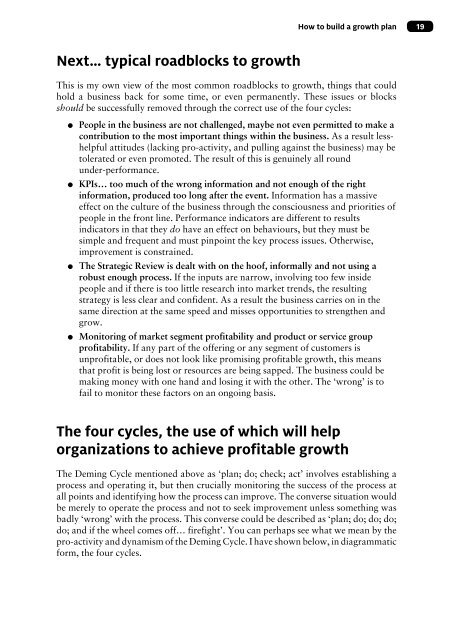The growing business handbook : inspiration and advice ... - Sparkler
The growing business handbook : inspiration and advice ... - Sparkler
The growing business handbook : inspiration and advice ... - Sparkler
Create successful ePaper yourself
Turn your PDF publications into a flip-book with our unique Google optimized e-Paper software.
How to build a growth plan<br />
19<br />
Next… typical roadblocks to growth<br />
This is my own view of the most common roadblocks to growth, things that could<br />
hold a <strong>business</strong> back for some time, or even permanently. <strong>The</strong>se issues or blocks<br />
should be successfully removed through the correct use of the four cycles:<br />
●●<br />
●●<br />
●●<br />
●●<br />
People in the <strong>business</strong> are not challenged, maybe not even permitted to make a<br />
contribution to the most important things within the <strong>business</strong>. As a result lesshelpful<br />
attitudes (lacking pro-activity, <strong>and</strong> pulling against the <strong>business</strong>) may be<br />
tolerated or even promoted. <strong>The</strong> result of this is genuinely all round<br />
under-performance.<br />
KPIs… too much of the wrong information <strong>and</strong> not enough of the right<br />
information, produced too long after the event. Information has a massive<br />
effect on the culture of the <strong>business</strong> through the consciousness <strong>and</strong> priorities of<br />
people in the front line. Performance indicators are different to results<br />
indicators in that they do have an effect on behaviours, but they must be<br />
simple <strong>and</strong> frequent <strong>and</strong> must pinpoint the key process issues. Otherwise,<br />
improvement is constrained.<br />
<strong>The</strong> Strategic Review is dealt with on the hoof, informally <strong>and</strong> not using a<br />
robust enough process. If the inputs are narrow, involving too few inside<br />
people <strong>and</strong> if there is too little research into market trends, the resulting<br />
strategy is less clear <strong>and</strong> confident. As a result the <strong>business</strong> carries on in the<br />
same direction at the same speed <strong>and</strong> misses opportunities to strengthen <strong>and</strong><br />
grow.<br />
Monitoring of market segment profitability <strong>and</strong> product or service group<br />
profitability. If any part of the offering or any segment of customers is<br />
unprofitable, or does not look like promising profitable growth, this means<br />
that profit is being lost or resources are being sapped. <strong>The</strong> <strong>business</strong> could be<br />
making money with one h<strong>and</strong> <strong>and</strong> losing it with the other. <strong>The</strong> ‘wrong’ is to<br />
fail to monitor these factors on an ongoing basis.<br />
<strong>The</strong> four cycles, the use of which will help<br />
organizations to achieve profitable growth<br />
<strong>The</strong> Deming Cycle mentioned above as ‘plan; do; check; act’ involves establishing a<br />
process <strong>and</strong> operating it, but then crucially monitoring the success of the process at<br />
all points <strong>and</strong> identifying how the process can improve. <strong>The</strong> converse situation would<br />
be merely to operate the process <strong>and</strong> not to seek improvement unless something was<br />
badly ‘wrong’ with the process. This converse could be described as ‘plan; do; do; do;<br />
do; <strong>and</strong> if the wheel comes off… firefight’. You can perhaps see what we mean by the<br />
pro-activity <strong>and</strong> dynamism of the Deming Cycle. I have shown below, in diagrammatic<br />
form, the four cycles.








